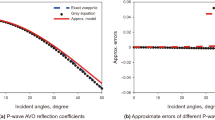Abstract
AVA inversion is an important tool for elastic parameters estimation to guide the lithology prediction and “sweet spot” identification of hydrocarbon reservoirs. The product of the Young’s modulus and density (named as Young’s impedance in this study) is known as an effective lithology and brittleness indicator of unconventional hydrocarbon reservoirs. Density is difficult to predict from seismic data, which renders the estimation of the Young’s impedance inaccurate in conventional approaches. In this study, a pragmatic seismic AVA inversion approach with only P-wave pre-stack seismic data is proposed to estimate the Young’s impedance to avoid the uncertainty brought by density. First, based on the linearized P-wave approximate reflectivity equation in terms of P-wave and S-wave moduli, the P-wave approximate reflectivity equation in terms of the Young’s impedance is derived according to the relationship between P-wave modulus, S-wave modulus, Young’s modulus and Poisson ratio. This equation is further compared to the exact Zoeppritz equation and the linearized P-wave approximate reflectivity equation in terms of P- and S-wave velocities and density, which illustrates that this equation is accurate enough to be used for AVA inversion when the incident angle is within the critical angle. Parameter sensitivity analysis illustrates that the high correlation between the Young’s impedance and density render the estimation of the Young’s impedance difficult. Therefore, a de-correlation scheme is used in the pragmatic AVA inversion with Bayesian inference to estimate Young’s impedance only with pre-stack P-wave seismic data. Synthetic examples demonstrate that the proposed approach is able to predict the Young’s impedance stably even with moderate noise and the field data examples verify the effectiveness of the proposed approach in Young’s impedance estimation and “sweet spots” evaluation.














Similar content being viewed by others
References
Aki, K., & Richards, P. G. (1980). Quantitative seismology. 2: Freeman.
Alemie, W., & Sacchi, M. D. (2011). High-resolution three-term AVO inversion by means of a Trivariate Cauchy probability distribution. Geophysics, 76, R43–R55.
Buland, A., & Omre, H. (2003). Bayesian linearized AVO inversion: Geophysics, 68, 185–198.
Connolly, P. (1999). Elastic impedance: The Leading Edge, 18, 438–452.
Daubechies, I., DeVore, R., & Fornasier, M. (2010). Iteratively reweighted least squares minimization for sparse recovery. Communications on Pure and Applied Mathematics, 63, 1–38.
Downton, J. E. (2005). Seismic parameter estimation from AVO inversion. Canada: University of Calgary.
Gidlow, P., Smith, G., & Vail, P. (1992). Hydrocarbon detection using fluid factor traces, a case study: How useful is AVO analysis: Joint SEG/EAEG summer research workshop.
Goodway, B., Chen, T., & Downton, J. (1997). Improved AVO fluid detection and lithology discrimination using Lamé petrophysical parameters; “λρ”, μρ, λμ Fluid Stack”, From P And S Inversions: SEG Annual Meeting 183–186.
Kabir, N., Crider, R., Ramkhelawan, R., & Baynes, C. (2006). Can hydrocarbon saturation be estimated using density contrast parameter: CSEG Recorder, C31–C37.
Ostrander, W. J. (1984). Plane-wave reflection coefficients for gas sands at nonnormal angles of incidence. Geophysics, 49, 1637–1648.
Quakenbush, M., Shang, B., & Tuttle, C. (2006). Poisson impedance. The Leading Edge, 25, 128–138.
Rabben, T. E., & Ursin, B. (2011). AVA inversion of the top Utsira Sand reflection at the Sleipner field. Geophysics, 76, C53–C63.
Russell, B. H., Gray, D., & Hampson, D. P. (2011). Linearized AVO and poroelasticity: Geophysics, 76, C19–C29.
Russell, B. H., Hedlin, K., Hilterman, F. J., & Lines, L. R. (2003). Fluid-property discrimination with AVO: A Biot-Gassmann perspective. Geophysics, 68, 29–39.
Sharma, R. K., & Chopra, S. (2015). Determination of lithology and brittleness of rocks with a new attribute. The Leading Edge, 34, 554–564.
Shuey, R. T. (1985). A simplification of the Zoeppritz equations: Geophysics, 50, 609–614.
Smith, G. C., & Gidlow, P. M. (1987). Weighted stacking for rock property estimation and detection of gas. Geophysical Prospecting, 35, 993–1014.
Yin, X., & Zhang, S. (2014). Bayesian inversion for effective pore-fluid bulk modulus based on fluid-matrix decoupled amplitude variation with offset approximation. Geophysics, 79, R221–R232.
Zhang, F., Wang, Y., & Li, X.-Y. (2012). Viabilities of seismic ray impedance and elastic impedance for hydrocarbon-sand discrimination. Geophysics, 77, M39–M52.
Zhang, S., Yin, X., & Zhang, F. (2009), Fluid discrimination study from Fluid Elastic Impedance (FEI). SEG Technical Program Expanded Abstracts, 28, 2437-2441.
Zong, Z., Yin, X., & Wu, G. (2012a). AVO inversion and poroelasticity with P- and S-wave moduli. Geophysics, 77, N29–N36.
Zong, Z., Yin, X., & Wu, G. (2012b). Elastic impedance variation with angle inversion for elastic parameters. Journal of Geophysics and Engineering, 9, 247.
Zong, Z., Yin, X., & Wu, G. (2013). Elastic impedance parameterization and inversion with Young’s modulus and Poisson’s ratio. Geophysics, 78, N35–N42.
Zong, Z., Yin, X., & Wu, G. (2015). Geofluid Discrimination Incorporating Poroelasticity and Seismic Reflection Inversion. Surveys In Geophysics, 36, 659–681.
Acknowledgements
We would like to acknowledge the sponsorship of National Nature Science Foundation Project (41604101), National Nature Science Foundation Project (U1562215), National Grand Project for Science and Technology (2016ZX05024-004), Natural Science Foundation of Shandong (BS2014NJ005), Science Foundation from SINOPEC Key Laboratory of Geophysics (wtyjy-wx2016-04-10) and the Fundamental Research Funds for the Central Universities.
Author information
Authors and Affiliations
Corresponding author
Rights and permissions
About this article
Cite this article
Zong, Z., Yin, X. Model Parameterization and P-wave AVA Direct Inversion for Young’s Impedance. Pure Appl. Geophys. 174, 1965–1981 (2017). https://doi.org/10.1007/s00024-017-1529-7
Received:
Revised:
Accepted:
Published:
Issue Date:
DOI: https://doi.org/10.1007/s00024-017-1529-7



